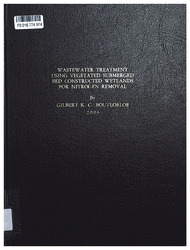| dc.contributor.author | Gaboutloeloe, Gilbert k. | |
| dc.date.accessioned | 2022-03-10T07:34:28Z | |
| dc.date.available | 2022-03-10T07:34:28Z | |
| dc.date.issued | 2006-12 | |
| dc.identifier.uri | https://hdl.handle.net/13049/390 | |
| dc.description | Thesis PhD, Washington State University, 2006 | en_US |
| dc.description.abstract | Vegetated submerged bed (VSB) constructed wetlands are engineered, low operation and maintenance cost wastewater and stormwater treatment technologies primarily designed for small facilities. The objectives of this dissertation were to evaluate the processes responsible forspatial distribution of nitrogen in VSB constructed wetlands in order to improve the nitrogen removal performance of this technology and present a model on direct atmospheric oxygen transfer into VSB constructed wetlands for rational system design. A design criterion for enhancing nitrogen removal in VSB formulated from reported studies was also suggested. Results from the nitrogen spatial distribution study conducted using a laboratory scale VSB constructed wetland demonstrated that there was vertical variation in nitrogen content in the water column of the VSB wetland system. The distributions of ammonium and nitrate nitrogen suggested that there was higher nitrification rate near the air/water interface than deeper into the water column,' contrary to the assumption in plug flow and completely mixed tank reactor models currently used for modeling VSB wetlands. The distributions may be attributed to direct atmospheric oxygen diffusion and/or plant supply in upper level and longer retention time . associated with flow resistance in the deeper zone caused by high root density. The direct atmospheric oxygen transfer accountable for nitrification in VSB was modeled using the modified two-film theory.
The model satisfactorily predicted the vertical dissolved oxygen (DO) profiles when compared observed data. Oxygen fluxes predicted from this model ran from 0.027 to 0.32 g m day. These are on the lower end of the range reported in literature and therefore can be used for conservative system design. Several emerging technologies for the enhancement of VSB aeration for improved nitrification were reviewed. The technologies reviewed demonstrated promising potential for nitrification and denitrification. However the net accumulation of nitrate nitrogen generated from the nitrification process was found to be the most limiting factor. This resulted from the depletion of organic carbon necessary for denitrification during aerobic respiration phase of the system. A designcriterion to alleviate the accumulation of nitrate nitrogen was suggested. Further development of these technologies to alleviate the nitrate nitrogen accumulation is recommended | en_US |
| dc.language.iso | en | en_US |
| dc.publisher | Washington State University | en_US |
| dc.title | Wastewater treatment using vegetated submerged bed constructed wetlands for nitrogen removal | en_US |
| dc.type | Thesis | en_US |

